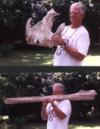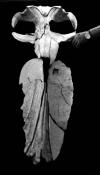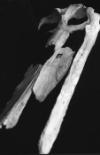Almost a fair trade.This post is about one of the local fossils that didn't make it into our museum. A local collector contacted me about a whale he had found in a local canal. It was under about 18 inches of water and he wasn't sure how to remove it. I met him at the locality a few days later and after careful probing I determined it was a mysticete skull. It was barely exposed in the top of the Ashley Formation. I found additional bones surrounding it just under the surface. A quick measurement showed that the skull was at least 6 feet long. I asked him if he would donate it to the museum and he declined. With my quick identification completed I left. A few days later he again contacted me and said he had the area sand bagged off and that the water had been removed from the enclosure. He said he needed help in removing it with minimal damage. I knew that he had previously sold local whale skulls to museums. I decided that it was in the best interest of science if I helped it get somewhere safe and in one piece. I met with him at the site and laid out the best approach to remove the skull, and mass of bones, in as few blocks as possible. His mode of removal would be paid students from a local Technical College. This meant that the blocks would have to weigh less than 400lbs. I donated a pile of burlap sacks for his plaster jackets and departed. Six months went by and one day I received another call. The plaster jackets had been taken to his friends house where they had been picking away at them. His friend was moving and he had to remove the blocks immediately. He lived in an apartment and had no place to put them. At this point I notified the museum and we came to an agreement that we would acquire the whalefor free and prepare it. In return, he would receive a cast and have it named after him. I went to pick up the whale and found that pieces of bone were scattered everywhere. As pieces fell of the exposed blocks they would be thrown into a box. It was a mess! I decide to do the preparation at my home lab because the person who had discovered the whale lived less than a mile away. He wanted to help in the preparation and couldn't go to the museum because his wife was under medical supervision at home. We worked on the material for five straight weeks. It turned out to be a new species of Early Oligocene mysticete. The day that I completed the last vertebrate the bomb fell. He informed me that there was a truck on it's way from North Carolina to pick up the whale. He had changed his mind and found a buyer for "HIS" whale. I contacted the museum and after a few hectic hours found out that legally the museum could not keep the whale because they had never had him sign a release form. I knew that I had been taken, but finally decided to spend the next two hours making a wooden crate to transport the whale skull safely. The owner swore that he would make it up to me for the hundreds of hours that I had invested in preparation and the materials used. And with that said the whale drove off into the sunset. But my story doesn't end here. True to his word, the owner gave me part of the sale proceeds. I, in turn, donated it to the museum to pay for a three year collecting project out west under a federal permit. Scratch one whale. Add several hundred new specimens to the collections. Almost a fair trade.
|
Location
| Dorchester County, South Carolina, USA |
| ID | 765 |
| Member | paleobum |
| Date Added | 1/17/2007 |
 |
| This is one of the blocks that had to be removed. The skull had both mandibles lying under it. Since it was six feet long it had to be broken at a point where there was an existing crack. |
|
 |
| This is one of the blocks packed with vertebrates and ribs. |
|
 |
| This is the back of the skull after it was removed from the main block. It was compressed and had to be taken apart and reshaped. |
|
 |
| The six foot long mandibles were crushed under the skull. Sections had to be reconstucted with fiberglass and epoxy. |
|
 |
| The skull was cleaned and then left in hardener for a week prior to it's reconstruction. |
|
 |
| This gives you some idea of the size of the whale. |
|
 |
| The skull layed out for viewing. The frontal area was only one quarter of an inch thick. It had to be hardened prior to removal from the block to keep it's shape. A long, tedious job. |
|
 |
| The skull with the mandibles under it. |
|
 |
| A side view of the skull. This specimen had completely lost all traces of teeth. All of the other known mysticetes from the Ashley formation have primitive teeth. This makes it the most advanced Early Oligocene mysticete known. I wonder where it ended up? |
|
 |
| One last view with the vertbra column. The prepared specimen measured over 14 feet long. In life it would have been around 25-30 feet long. A large portion of the vertebrate column is articulated and is still in the wall of the canal. I removed two vertebra a year later but decided to leave the rest. |
|
|